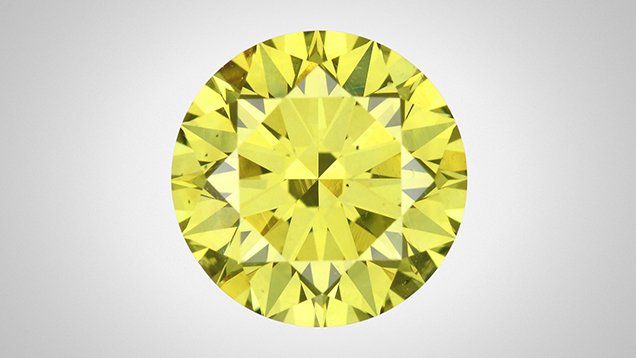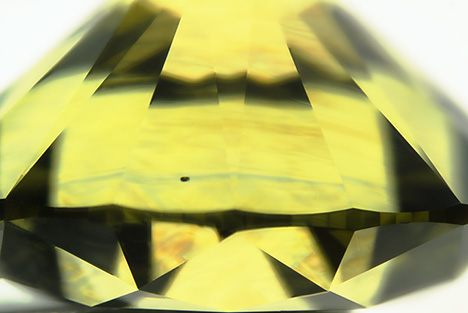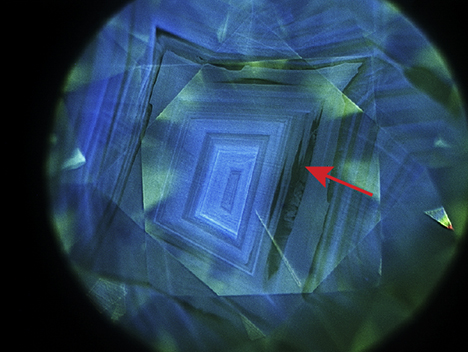Blue “Graining” in Green-Yellow Diamond

It is not uncommon for fancy-color diamonds to possess uneven color distribution. This is generally seen as diffuse concentrations of color that may arise from changes in growth environment, natural or artificial irradiation, or as linear graining. Color zoning from radiation is often diffuse and blue or green in color, whereas graining exists as sharp distinct lines and is typically brown, pink, or yellow in color. Blue color zones resembling graining, however, were recently observed in a 1.50 ct Fancy Intense green-yellow diamond (figure 1) at the Carlsbad laboratory.
The diamond was type IaAB and showed clear spectroscopic evidence of both high-pressure, high-temperature (HPHT) treatment and artificial irradiation. Under magnification, the stone showed reflective cubic graining and strong green luminescence with fiber-optic lighting. When immersed, it revealed a blue colored crown (created during the artificial radiation color treatment) and a yellow pavilion. This type of color zoning is unusual, as artificial radiation is typically done on the pavilion of faceted diamonds, not the crown. When viewed under magnification with diffused light, the stone displayed yellow and brown graining as well as peculiar blue grain lines (figure 2). Graining is associated with regions of planar lattice deformities, or plastic deformation that formed when the diamond was deep in the earth’s mantle. Colored graining occurs when regions of plastic deformation coexist with clusters of lattice vacancies or complex nitrogen defects.

Blue graining has rarely been seen as a cause of blue coloration in treated or untreated diamonds. Blue color is almost always a result of trapped boron atoms within the diamond lattice (type IIb; usually with a uniform color distribution) or exposure to natural or artificial radiation (usually with a patchy color). Given that no boron impurities were seen in the infrared spectra, radiation damage was most likely the cause of this blue “graining.”
When diamonds are analyzed with DiamondView, nitrogen-rich areas often show strong blue fluorescence due to N3 defects while lower-nitrogen areas (type IIa) are sometimes inert. The diamond showed strong blue fluorescence in an octahedral growth pattern with streaky inert patches (figure 3). These inert streaks appeared to correspond with the location of the blue zone, as seen under magnification in diffused light. When viewed through the pavilion, the zoning on the crown has a grain-like appearance (figure 2).

We propose that the blue zone with a grain-like appearance formed during artificial irradiation treatment within a region of diamond containing very low nitrogen impurities. Initially, this stone likely had a brown color. HPHT treatment then influenced the bodycolor by destroying the initial brown color before creating most of the yellow component as well as green luminescence. When artificial irradiation treatment followed, we believe that vacancies were created in higher concentrations within the low-nitrogen regions to create the blue color zone. This is similar to the way type IIa diamonds are HPHT treated and irradiated to a blue color. This stone is a fine illustration of how inherent heterogeneities of impurity distribution within diamond can be differentially affected by treatments.



